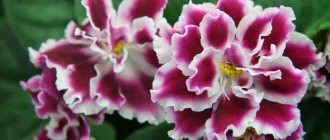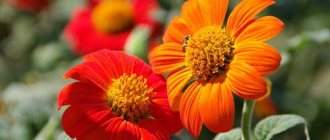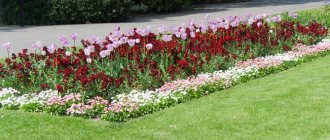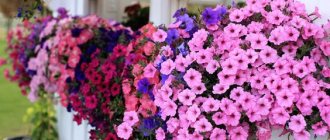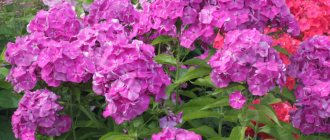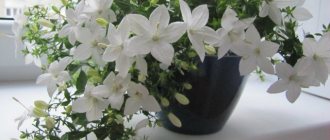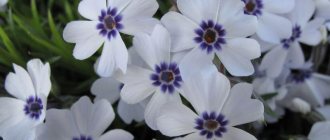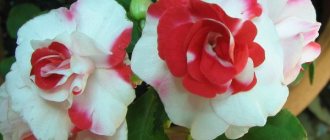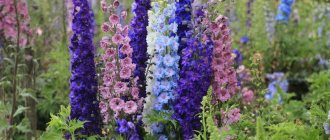Author: Natalya Category: Garden plants Published: February 24, 2019Republished: February 24, 2019Last edits: November 03, 2020
- When to plant
- Growing conditions
- Foreign nasturtium (Tropaeolum peregrinutn)
Nasturtium is a plant as common in our gardens as marigolds or tulips. The peak of its popularity has long passed, but the habit of growing nasturtium was passed on to us from our grandmothers and mothers. Why is nasturtium so good? She is beautiful, useful, completely unpretentious to the conditions and does not require special care. Today, more than twenty species and many varieties of this cute, useful and edible plant are grown in garden culture. From our article you will learn:
- what types and varieties of nasturtium exist;
- how to sow and grow these flowers in the garden;
- what are the medicinal properties of nasturtium and how can you use them.
Planting and caring for nasturtium
- Planting: sowing seeds in open ground in mid-late May or sowing seeds for seedlings in April, followed by planting seedlings in the ground in the first ten days of June.
- Lighting: bright sunlight.
- Soil: light, not too fertile, well-drained, slightly acidic.
- Watering: from the beginning of the growing season - regular and plentiful, during flowering - as the soil dries.
- Fertilizing: 1 time per week before flowering with potassium-phosphorus fertilizers. No nitrogen needed. From the beginning of flowering, feeding is stopped.
- Reproduction: seeds and cuttings.
- Pests: aphids, cabbage moths, whites, spider mites.
- Diseases: gray mold, rust, viral mosaic, black ring spot and bacterial wilt.
Read more about growing nasturtium below.
Nasturtium (lat. Tropaeolum) , or capuchin , belongs to the Nasturtium family, and is a herbaceous plant, of which there are about 90 species. The nasturtium plant is native to South and Central America, but it has been established in our latitudes for a long time and reliably, since it is distinguished by its unpretentiousness, sought-after healing properties and taste characteristics. The main thing is that the nasturtium flower, with its long flowering, can decorate any, even the most sophisticated garden. The capuchin flower, brought from Holland to Russia, was called so because of the shape of the flower, reminiscent of a hood, but gradually the plant began to be called nasturtium. The official Latin name Tropaeolum was assigned to nasturtium by Carl Linnaeus.
Summer care
It is necessary to care for nasturtiums during the summer: remove weeds, water and loosen the soil, apply fertilizers.
Watering
Water with warm water. The first weeks, until the flowers appear, are watered abundantly, after which they are watered only as the soil dries out. Otherwise, green mass will grow and there will be no flowers.
Top dressing
Moderate fertilizer is required.
Important! From an excess of fertilizer, the green mass will grow, and rare flowers will be lost in it. In order for the flowers to be large and in large quantities, you should not add organic matter and nitrogen.
Feed nasturtium once a month. For example, 30 g of nitrophoska or the drug “Agricola-rose”, which will be dissolved in 10 liters of water and watered under each bush with 1 liter of solution.
You can stimulate lush flowering by removing faded flowers. Dead leaves and stems are trimmed with a sharp knife.
Botanical description
Nasturtiums, both annual and perennial, are often vines with succulent stems, and sometimes subshrubs. The leaves are most often lobed, alternate, entire, palmate or thyroid. Flowers - simple, double and semi-double - irregular in shape, fragrant, zygomorphic, bisexual, axillary, consisting of five (sometimes more) petals, the same number of sepals, funnel-shaped tubes with nectar.
The color of the flowers is most often red or yellow. The fruit consists of three wrinkled kidney-shaped lobes, in each of which round, kidney-shaped seeds ripen. Both flowers and stems have medicinal properties and are also of interest to culinary specialists.
- Ixia: cultivation and care, types and varieties
Description
There are varieties of nasturtium:
- annuals;
- perennial.
As a rule, a long vine with bright leaves and flowers grows. Also available in shrub form.
The flowers exude a distinct aroma and according to the appearance of the buds there are:
- semi-double;
- terry.
The bud has 5 petals that start from the cavity. Nectar collects inside the flowers. Most often, the flowers are colored in shades of yellow, red and orange.
In cooking, flowers are added to soups, salads and used to decorate various dishes.
- Dry, crushed ones are used instead of ground black pepper.
- The pickled fruits are similar to capers.
- Vinegar and oil are made from nasturtium.
Growing nasturtium from seeds
Sowing seeds
Nasturtium propagates by seed, and even a beginner can cope with it. Large nasturtium seeds are sown directly into open ground in mid- or late May, after the last frost has passed. Nasturtium seeds are placed in holes up to two centimeters deep, located at a distance of 25-30 cm from each other, in a nesting manner - 3-4 pieces per hole. If there is a possibility of nighttime drops in temperature, cover the seeded area with plastic wrap or other covering material and use only warm water for watering. In a week or two, shoots will appear.
Planting and caring for cosmos - everything you need to know
In the photo: Nasturtium seeds
Growing seedlings
Nasturtium is also grown in seedlings, which allows for earlier flowering than in the case of sowing seeds directly into the ground. To do this, use peat cups or cups with a retractable bottom, into which 2-3 seeds are sown in April-May to a depth of 2 cm. The temperature in the room with seedlings should be 20-22 ºC. Shoots will appear in a couple of weeks.
Make sure that the seedlings have enough light, because the lack of lighting makes them stretch out, and after planting on the site they get sick for a long time and do not bloom.
The root system of nasturtium is weak, and the leaf surface is quite large, therefore, in order not to injure the roots, the seedlings are not picked and transplanted into the soil along with a lump of earth, right in a cup.
Planting in open ground
Seedlings are planted in open ground in the first ten days of June, depending on the weather. Low-growing plants are planted at intervals of 20–25 cm, long-climbing plants – 40–45 cm.
If the air temperature is unstable, then at night the plantings are protected from the cold with covering material. Nasturtium is heat-loving, and for young plants, cold snaps and frosts at night are a big stress.
In the central zone, nasturtium is sown in open ground in the last ten days of May. The main advantage of sowing in open ground over the seedling method is the minimal risk of damage. The plants will be immediately planted in a permanent place, their root system will not be damaged during transplantation. There is no need to rush with sowing - the soil should warm up well. Even short temperatures of 0°C can kill tender sprouts.
The seeds are pre-soaked, as with the seedling method. In the rows, holes are marked every 30–35 cm, 2–4 seeds are placed in each at a depth of 2–3 cm. After sowing, the beds are watered. Flowering at this time of sowing will begin at the end of June.
To get flowering plants 2-3 weeks earlier, planting dates are shifted. To do this, you need to prepare the ground. The earth is watered with hot water. Sowing is carried out in heated soil and covered with film. The emerging seedlings are ventilated and watered with warm water, avoiding waterlogging. The shelter is removed in the first ten days of June. Seed germination is negatively affected by cold air, waterlogging, deep seeding, and sowing in heavy clay soils.
Planting nasturtium
When to plant
Nasturtium is planted in the first ten days of June. Find a place in your garden that is well-lit and sheltered from the wind, since nasturtiums do not bloom as profusely in the shade as they do in good light. The soil on the site should be slightly acidic, with good drainage, light and fertile. On soils rich in organic matter, the plants turn lushly green, but do not want to bloom; on soils that are too poor, the flowering of nasturtium is not so beautiful, the leaves are small, and the stems look bare. In stagnant, moist soils, nasturtium rots.
In the photo: Blooming yellow nasturtium
How to plant
So, it’s the beginning of June, it’s time to plant the seedlings in open ground. Planting of seedlings is carried out together with a ball of earth, and if you sowed seeds in peat pots, then directly with the pots to avoid breaking or breaking the fragile roots. Depending on the variety of nasturtium, the distance between specimens should be 20-40 cm. At first, it is advisable to cover the planting at night. Nasturtiums will bloom in a month and a half.
Growing seedlings
For seedlings it is better to use:
- biocontainers (pressed vermicompost in granules);
- peat pots or tablets;
- cups with a removable bottom (diameter 10 cm).
Advice! Nasturtium has weak roots, so it is not recommended to pick it.
When growing seedlings in peat tablets, they are transplanted into a pot when 2 main leaves appear. The tablets will dissolve in the soil and further fertilize the soil.
Grown seedlings are transplanted together with a ball of earth, peat pots or biocontainers. Before this, the plants are hardened off - taken outside for 2-4 hours a day in warm weather. Nasturtium will bloom in 30-45 days.
Preparing seeds and soil
Seeds are prepared before sowing:
- Sorted, removing underdeveloped, small and damaged ones.
- Then they are disinfected by placing them in a solution of potassium permanganate for 15 minutes, heated to 60 degrees.
- Next, the seeds are wrapped in gauze and kept in cool water for 24 hours.
- They can also be germinated a little and then planted in pots.
You can buy soil at a garden store or make it yourself by combining in equal proportions:
- turf land;
- sand;
- peat.
All components are mixed well and sifted. Next, the soil is watered with a hot solution of potassium permanganate for disinfection and left at room temperature for 1-2 days.
The soil is poured into prepared containers and the seeds are sown.
Advice! Instead of a solution of potassium permanganate, you can use a solution of Fitosporin.
Sowing
Important! If nasturtium will grow indoors, the seeds are sown immediately in a permanent pot.
- Make a 2 cm depression in the soil and place 2-3 seeds in each container.
- The soil is lightly compacted and watered with warm water from a spray bottle so as not to wash out the seeds.
- Peat tablets are placed in a container and watered. 1-2 seeds are placed in each tablet.
- The containers are left on a bright and warm windowsill.
Seedling care
The room where the seedlings are located should be 20-22 degrees. Then the sprouts will appear in 13-15 days. After 2 weeks of cultivation, the temperature is lowered by 2 degrees.
In poor lighting, the seedlings will begin to stretch, so in the future they will be weak. It is necessary to additionally illuminate the plants with phytolamps so that the seedlings receive daylight for 15 hours.
Watering is carried out as the soil dries. Nasturtium loves dry air, so it does not need to be sprayed.
Important! Moisture should not get on the plants. If possible, it is better to pour water into the pan.
The strongest plants are left in the container with seedlings, and the rest are removed.
Planting in open ground
The place for nasturtium is chosen to be protected from drafts and well lit. The soil must be fertile, water- and breathable with weak acidity. If the soil is not nutritious, the flowering will be weak and not lush.
Advice! If there is a lot of organic matter in the soil, there will be a lot of greenery, but there will be no flowers. Nasturtium loves mineral fertilizers.
Depending on the climate, transplantation into open ground is carried out from early May to early June on a sunny and warm day. By this time, the seedlings should already have grown to 7 cm.
A minimum of 20 cm is left between plants, and for tall and bushy varieties - 40 cm. The holes are dug slightly larger than the volume of the cups with seedlings.
The plant is transferred into holes with a lump of earth, soil is added and watered at the root. Plantings are mulched with peat and compost.
Advice! The first time after transplanting, it is better to cover the plants with film at night.
Watch the video! Nasturtium: cultivation and care
Nasturtium care
Growing conditions
Caring for nasturtium involves weeding the area and watering the plants. If you mulch the bed after planting, you won’t have to fight weeds.
At the very beginning of growth, regular and abundant watering is very important, but when the nasturtium blooms, the area should be watered only when the soil dries out: if the soil is wet all the time, the plant will be lushly green, but there will be few flowers.
It is necessary to promptly remove dried flowers, unless you need seeds, but to collect seeds for next year, it is enough to leave just a few ovaries to ripen.
Feed nasturtium weekly with potassium-phosphorus fertilizer until it blooms. Nasturtium will not need nitrogen fertilizers.
How to plant and grow sweet peas - pro tips
Propagation of nasturtium
In addition to the seed method, a vegetative method is also used to propagate nasturtium - cuttings. Cuttings are rooted in wet sand or water. Most often, terry varieties of nasturtiums or new ones, the seeds of which are difficult to find in flower shops, are propagated this way. The vegetative method allows you to preserve species and varietal characteristics during propagation.
- How to plant Brugmansia in the ground (video)
Pests and diseases
Nasturtium is not only beautiful, but also very useful. In addition, it somehow inspires fear in Colorado beetles, whiteflies, aphids, cabbage beetles and other insect pests.
But diseases sometimes affect nasturtium, primarily such as bacterial wilt, which is expressed in weakening of the lower leaves, and then withering of the entire plant.
Or gray rot, which appears as dry brown spots on the leaves. From time to time, brown or black rust spots or variegated mosaic stains appear on nasturtium leaves. If affected by these diseases, infected specimens must be removed and burned, and healthy plants must be treated with special preparations that destroy the causative agents of the disease.
In the photo: Growing red nasturtium
Care
Watering
The large mass of green leaves and stems requires regular watering. Young plants especially need water during the growth period and in dry, hot weather. An adult nasturtium can easily tolerate short breaks in watering. Surprisingly, a plant torn out of the ground does not wither for a long time and continues to bloom - it is helped by the moisture accumulated in the succulent stems. After watering, the soil around the plantings is loosened and weeded.
Feeding
Nasturtium does not tolerate fertilizers with fresh organic matter and is responsive to phosphorus-potassium fertilizers. Nitrogen fertilizers are best used as foliar sprays. It is useful to treat young plants 1–2 times with a solution of urea or humate. The nasturtium bushes will become strong, the leaves will be powerful and bright green. Plants are fed with complex mineral fertilizers every 4–6 weeks.
How to prolong flowering?
Flowering of nasturtium begins 1–1.5 months after emergence and lasts until frost. To ensure long flowering without interruptions, faded flowers are regularly plucked off - this stimulates the formation of new buds. Only those inflorescences from which ripe seeds will be collected are left.
How to collect seeds
If you want to do some breeding, you can collect nasturtium seeds yourself. As the flowers fade, the seeds ripen. It must be remembered that the seeds of all types of nasturtium have time to ripen before frost, the only exception being foreign nasturtium. When the seeds ripen, they turn from green to whitish and, easily separated from the peduncle, fall to the ground.
Therefore, be careful and try to collect them before they fall off.
Store ripe seeds in cardboard boxes. Foreign nasturtium seeds are collected unripe and ripened at home.
In the photo: Large orange nasturtium flowers
Likes, doesn’t like – secrets of agricultural technology
Behind the unpretentiousness of a flower and the simplicity of its agricultural technology, as always, lies knowledge. About its origin, biological characteristics, vegetation cycle. Nasturtium also has secrets.
sun flower
She is light- and heat-loving, like a real native of the tropics. If you plant nasturtium in partial shade, it will “wrap itself up” in leaves and bloom much worse. To reach its full potential, it needs sun. A lot of sun.
It also needs “tropical” watering - infrequent, but plentiful, so that the soil is wet to the last root. During flowering, it is generally better not to rush with watering, wait for the soil to dry out, and then give a moisture-recharging dose.
The heat-loving nature of the flower is also manifested in the fear of the slightest frost. Never rush into sowing, let alone planting seedlings; wait for steady spring warmth.
More of a gourmet than a glutton
Installation - the more fertile the soil, the better, it does not work for nasturtium, and this must be the case when planting and caring for the plant.
On oily soil rich in humus, it drives away the foliage and blooms worse. There is no need to keep her from hand to mouth either, but it is better to feed her less often and with targeted “goodies” - mineral complex fertilizers for flowers. It is better to avoid manure, mullein, humus and other organic matter altogether.
Types and varieties
In the wild, in its homeland, perennial nasturtium grows, but in our gardens the tropical beauty cannot remain in the ground for the winter, so it is grown as an annual. Of the cultivated species of nasturtium, the most commonly grown are:
Foreign nasturtium (Tropaeolum peregrinutn)
Or Nasturtium Canarian - a vine from South America, the light green stems of which reach a length of 350 cm and very quickly weave arbors and trellises. It blooms from mid-summer until frost with bright yellow small flowers with corrugated petals and green spurs. The leaves are medium-sized, five- or seven-parted. Seeds in the middle zone do not have time to ripen naturally.
In the photo: Large nasturtium (Tropaeolum majus)
Large nasturtium (Tropaeolum majus)
Very branched, bare, fragile stems reach a length of 250 cm. If the variety is erect and not creeping, then the stem grows up to 70 cm in height. Blooms profusely from June until autumn frosts. It reproduces well by self-sowing, the seeds do not lose their viability for up to 4 years. The leaves are asymmetrical, large, rounded, thyroid-shaped, the surface is light green, the underside is glaucous, the petioles are long, the diameter is about 8 cm. The species is represented by dozens of varieties, including compact bush forms:
- King Theodore - bright red flowers;
- Peach Melba - cream flowers with red spots in the center;
- Salmon Baby - semi-double, salmon-colored flowers;
- Ladybug - apricot-colored flowers with burgundy spots in the middle.
Nasturtium (Tropaeolum cultorum)
It combines hybrids of shield-bearing nasturtium and large nasturtium, the stems are densely leafy, the leaves are green or purple, thyroid. Varieties of this species differ in shape and height: there are compact varieties of nasturtium (up to 50 cm in height), creeping ones, with shoots up to 4 m long, or dwarf varieties - 15-20 cm in height. Varieties:
- Gleming Mahagani - a bush up to 37 cm tall with double red flowers;
- Golden Globe is a spherical bush up to 25 cm high and 40 cm wide with round light green leaves and large (up to 6.5 cm in diameter) double golden-yellow flowers;
- Moonlight is a climbing plant, the stems of which reach two meters in length, the flowers are pale yellow.
In the photo: Large nasturtium (Tropaeolum majus)
Small nasturtium (Tropaeolum minus)
Branched, grooved thin stems up to 35 cm tall, the leaves of nasturtium minor are round, small, shield-shaped, the petioles are very long and thin. Small flowers up to 3 cm in diameter are yellow in color with dark spots, the three upper velvety petals are pointed along the edge, the spurs are cylindrical and curved. This type of nasturtium blooms from June to October. Varieties:
- Cherry rose - grows up to 30 cm in height, blooms with bright red double flowers;
- Black velvet - the same 30 cm in height, simple flowers up to 6 cm in diameter, so dark burgundy that they are almost black. This variety is sometimes called Black Lady.
Shield nasturtium (Tropaeolum peltophorum)
This is a creeping subshrub, the dark green, succulent and fragile shoots of which reach 4 m in length. The leaves are thyroid-shaped, dark green. The flowers are a juicy dark red hue. It blooms from June to October, the seeds ripen well. The most common variety:
- Lucifer is an erect bush up to 25 cm tall, the shoots are light green, the leaves are large, dark green with a dark red tint. The flowers are simple, up to 6 cm in diameter, red-orange.
In the photo: Lilac nasturtium
Among other types of nasturtium, distinguished by their decorative properties, one can name nasturtium azure, ciliated, many-leaved, beautiful, tricolor and others, but, unfortunately, few can boast of experience in growing these species in our climate zone.
- Pine: planting and care, reproduction and types
Brief description of the plant
Nasturtium flower is an annual plant belonging to the nasturtium family (Tropaeolaceae). The genus includes about 90 species, the most famous are:
- Canarian nasturtium (liana) (Tropaeolum peregrinum);
- thin-leaved (T. leptophyllum);
- small (T. minus);
- large (T. majus).
Large nasturtium (T. majus) comes from South America - Peru, Bolivia. Today it is grown all over the world as an ornamental plant. In nature, the species occupies coastal habitats and areas from sea level to 3000 meters. Climbing nasturtium repels snails.
Low-growing nasturtium is usually planted as borders and along paths - a plant up to 20 cm high, which is a flowering bush.
Ampelous varieties look very beautiful in a pot or flowerpot.
The leaves are rounded, with various veins. Large yellow, orange or red flowers bloom from July to September, seeds ripen from August to October, petals are single or double.
Nasturtium flowers are bisexual (have male and female organs). The plant prefers light (sandy) and medium (loamy) soils, loves areas with good moisture and can grow on weak substrates.
Medicinal parts of the plant: fresh or dried leaves, flowers, fruits. The main beneficial substances contained in the plant are glucosinolates, mustard oil, flavonoids, carotenoids, vitamin C. The plant can act as a disinfectant, healing agent, and has strong antibacterial properties.
Medicinal properties of nasturtium
Nasturtiums are not only beautiful, but also edible and medicinal. The leaves and flowers of young plants are used as ingredients in salads, used to decorate dishes, and added to sandwiches and soups. Pickled nasturtium fruits taste like expensive capers. And dried and ground seeds can be used as a seasoning instead of black pepper, at least this was done during the Second World War. All parts of the plant are edible except the roots.
In the photo: Beautiful nasturtium flower
The healing properties of nasturtium have also been known for a long time. It treats skin rashes, stimulates hair growth, and helps with anemia, vitamin deficiency, and kidney stones. The plant has proven itself well as a means of combating scurvy, since the amount of vitamin C in it is ten times greater than in lettuce leaves. In addition, nasturtium contains substances that successfully fight microbes - provitamin A and phytoncides.
Dishes prepared from nasturtium are included in the therapeutic diet for metabolic disorders in older people and atherosclerosis. The rhizomes of tuberous nasturtium species contain substances that lower testosterone levels in the blood, which may be necessary in certain cases. Modern science has established that nasturtium has the following properties valuable for medicine: anti-inflammatory, laxative, diuretic, diuretic, antiseptic, antibiotic, antiscorbutic, uroseptic, expectorant.
However, you should be aware that an overdose of nasturtium provokes irritation of the gastrointestinal mucosa.
Possible problems in growing
If not cared for correctly, many gardeners wonder why the plant does not bloom. Such symptoms can appear for several reasons.
Pests
Thanks to its bright aroma, the plant is often used in the country to repel pests. However, in rare cases, parasites such as caterpillars may appear on the nasturtium itself. To combat them, it is necessary to pollinate the bushes with wood ash.
Pests of nasturtium
Diseases
Nasturtium has high immunity to diseases. However, in some cases the following problems may occur:
- bacterial wilt;
- spotting;
- gray rot.
When the first signs of the disease appear, the affected area is carefully trimmed.
Important! To prevent the plant from being exposed to diseases, it is necessary to soak the seeds in a light solution of manganese before planting.
Signs of improper care
If not properly cared for, the plant may not form inflorescences. The following factors may be the reasons:
- Use large amounts of water for irrigation. It is necessary to water the plant in small quantities so that the soil is moistened superficially. The accumulation of water leads to the appearance of rot in the root system.
- Use of fertilizers in large quantities. This is especially true for nitrogen-containing substances. Nitrogen provokes the appearance of green mass, but inflorescences will not form. Therefore, it is recommended to alternate different substances during feeding.
- Planting a plant in the shade. Nasturtium prefers sunny places, so planting near buildings and in the shade of trees is not recommended.
Caring for and growing crops in open ground is not difficult if you follow the recommendations of experienced gardeners.
Diseases and pests
Nasturtium is not damaged by pests such as cabbage grass, aphids, whiteflies or Colorado beetles. Therefore, the flower is often planted between cabbage or nightshade crops to reduce the number of pests.
Other insects love nasturtium, as it is an excellent honey plant for them.
The plant is most often affected by bactericidal wilt. The leaves below first weaken, then the whole plant dies.
Rust appears as black or brown streaks and spots on the plant. Brown spots appear on the leaves due to gray rot.
When affected by mosaic, motley and bright stains appear on flowers. You can also notice the manifestation of the ring and leaf spot virus on them.
Affected plants are removed from the site and burned. The well is treated with a solution of potassium permanganate (it must be hot). Healthy flowers are treated with insecticides such as Topaz, Ridomil, Oksikhom.
Nasturtium against pests
Several bushes of a plant planted at the entrance to the greenhouse drive away a dangerous pest - whitefly, and dry parts of shoots and leaves will protect orchids and other indoor flowers from this pest.
Nasturtium planted near peonies prevents the development of fungal diseases on the root collars of plants.
Sown in the tree trunks of young cherries and apricots, it protects the trees from the invasion of various garden pests, and when dug into the ground in the fall it turns out to be a good green fertilizer.
Nasturtium is a garden plant of remarkable beauty, which is also used in cooking and folk medicine, as well as to protect other inhabitants of flower beds and indoor spaces from insect pests.
Planting seeds for seedlings
The advantage of growing through seedlings:
- early flowering;
- germination guarantee;
- strong healthy seedlings.
Flower growers have invented a variety of methods for sowing seeds, each of which has its own advantages and gives excellent results.
Traditional way
This method is no different from sowing seeds of other annual flowers and has two options.
- The seeds are placed in a common container. When 3-4 true leaves appear, the seedlings dive into separate pots. The downside is the fragile stems and roots of nasturtium, which are easily damaged during transplantation.
- Sowing in individual containers. The soaked seeds are placed in cups, peat tablets, pots, buried 1-1.5 cm into the soil.
Nasturtium seeds are large and spreading them is not difficult.
In both cases, the container with planted flowers is covered with plastic film, a bag or glass and placed in a warm place with a temperature of 20-22 degrees.
Planting in sawdust
An unconventional method - germination in sawdust - is suitable for subsequent picking. In this case, the sprouts are easily removed and are not damaged.
Sawdust is placed in a container in a layer of 3-3.5 cm. Pour boiling water over it until completely moistened. Sawdust should not be allowed to float in the water; the substance should be loose. They should just be wet.
Make holes in hot sawdust at a distance of 4-6 cm and place dry grains in them. Pre-soaking them is not required with this method of planting.
Place bags over the container and place them in a warm place for germination. The seeds do not need light at this stage. The container is transferred to a sunny place after 5-6 days, when the first shoots appear.
When all the seeds have sprouted and 2-3 full leaves appear on the sprouts, they are transplanted into separate containers. The seedlings are quickly and without damage removed from the loose sawdust.
For the base, use sawdust from deciduous trees or compressed sawdust pellets for filling cat litter boxes. In conifers, due to the high resin content, the seeds will not germinate.
Growing nasturtium without soil
To be sure of the emergence of seedlings, the seeds are pre-germinated. No soil is required for this.
Cotton wool is spread into the container and watered with water with the addition of a growth stimulator. Seeds are placed on wet cotton wool at a distance of 2 cm from each other. Cover the top with another layer of cotton wool or cotton pads. The liquid should saturate both layers of cotton wool, since seeds require a lot of moisture to germinate.
After the first shoots appear, the seedlings are placed in separate cups. It is recommended to do this with tweezers, as the sprouts are very fragile.
A clean and replant-free way to grow seedlings is to sow them in peat tablets. Maintenance of the plantings in them is minimal, as only watering is required. All nutrients are already in the filler.
- Place the tablets in a tray.
- Pour warm water for 30 minutes.
- Drain excess liquid from the pan.
- Deepen the seeds 10-15 mm into the recess of the tablet.
- Cover with plastic.
Plant seedlings directly with the tablet. This is the most gentle way of growing.
Landing in the "snail"
A popular way to obtain seedlings is in “snails”. Rolls are made with earthen soil or replaced with paper napkins or toilet paper.
To do this you will need:
- strip of dense polyethylene or backing for laminate size: 10 cm x 100 cm;
- toilet paper or napkins. Their quantity should be enough for 2 layers along the entire length of the film strip;
- 2-3 rubber bands for banknotes, rope or tape;
- round container.
Roll making process:
- Unfold the plastic on the table.
- Place paper over it.
- Dilute 3 drops of Epin in 1 liter of water and moisten the napkins.
- Spread dry seeds 4-5 cm apart, 15 mm from the edge. This will be the top edge.
- At the end, leave 10-15 cm without seeds.
- Roll the tape into a tight roll, making sure that the seeds do not move.
- Secure the film with tape, rubber bands or twine.
- Place the “snail” in a container with pre-filled warm water.
- Cover the top with a bag to create a greenhouse effect.
To make a roll of soil, soil is laid out instead of paper. All other actions are the same.
After green sprouts appear, the bag is removed and the bucket with the roll is placed in a bright place.
When 2-3 leaves grow on the seedlings, picking is necessary. To do this, the “snail” is placed on the table and carefully unfolded. The seedlings do not have to be pulled out or divided. All roots remain intact and easily take root in a new place.
Botanical features of the plant
Nasturtium came to Russia from Holland as a decoration for garden design. It looks impressive for several years due to the unique shape of the inflorescence. It is proposed to grow not only perennial varieties, but also annual ones. The species is chosen at will, since the capuchin often looks like a liana, and is also available in the form of a shrub.
The appearance of the flower depends on the variety:
- leaves: arranged alternately;
- the shape can be palmate, shield-shaped, entire-edged, lobed;
- fragrant flower;
- petals: double, simple, semi-double;
- inflorescences of irregular shape. Bisexuality is monitored. Axillary;
- a flower always consists of 5 petals and the same number of sepals;
- tube shape: funnel-shaped, there is nectar in the middle;
- color; in 90% of cases it is either red or yellow.
Reproduction occurs by seed. During fruit ripening, 3 wrinkled cotyledons are formed, similar to buds. Here are the seeds, the shape of which is rounded and kidney-shaped.
Interesting fact! Nasturtium is not just a beautiful garden flower. Its main properties are called medicinal qualities. Also, shoots and inflorescences are widely used in cooking as spices.
Features of care
to successfully growing nasturtium:
- The plant is heat-loving and is best sown in April for seedlings;
- transplantation is difficult; peat cups are recommended for growing seedlings;
- with a lack of sunlight, the shoots will be stunted and there will be few flowers;
- The soil needs to be well-drained and moderately fertile;
- when feeding with phosphorus and potassium, many flowers are formed;
- the soil should be moderately moist.
How to care for Nasturtium seedlings, what are the tips for growing them?
A specific stage of seedling growth is combined with specific instructions for its maintenance. At the first stage of seed growth, the containers in which they are placed need to be covered with polyethylene. This point is important because... triggers the growth mechanism due to the greenhouse effect. The first shoots will appear within two weeks. Until they appear, the soil must be moistened regularly, but only with a syringe or sprinkler.
The nasturtium seeds have sprouted, what to do next?
As soon as the first shoots appear, the film covering them is removed, and the container itself is placed in a bright place to provide the required amount of light. For proper growth, sunlight should illuminate the shoots for at least 12-16 hours. If there is not enough light for the sprouts, they will begin to stretch in length, then weaken and stop developing. From the moment the sprouts appear, the temperature is maintained in a certain way: it cannot be less than 18 degrees, but it cannot be above 22 either. The emerging shoots require constant watering, depending on the frequency of drying out of the soil.
How to feed Nasturtium seedlings?
For a luxurious and long flowering period, nasturtium needs to be fed with fertilizers. At the beginning of planting seeds, the application of mineral fertilizers containing nitrogen is required, but when the shoots have sprouted and gained strength, it is necessary to switch to fertilizing containing potassium.
The first fertilizing is done with nitrogen-containing fertilizers no later than ten days after planting in the ground. The deadline is two weeks. Thanks to this, the flower is activated in growth and the first inflorescences appear.
The second feeding is done with fertilizers based on phosphorus and calcium and is repeated no later than after half a month. With the help of the second feeding, nasturtium will begin to actively grow and gain strength for luxurious flowering.
Rules for picking Nasturtium
This process is considered the most difficult, because raises many questions. The method of ordinary pinching a plant is not suitable here, since it does not bring the expected results. Replanting nasturtium can have a bad effect on it due to the weakness of the root system. If possible, it is better to do without picking at all. However, if the shoots have grown very long and there is a need for picking, then when replanting them, bury the nasturtium sprouts into the soil until the very beginning of the first leaves.
IMPORTANT! It is best to plant this flower immediately in a high container, so that if necessary, you can simply add the required amount of soil and do without picking.
When and how to collect nasturtium seeds
Collecting nasturtium seed material is not always possible due to the peculiarities of the development of the culture. The main thing here is not to have time to cut off the seed pods, but for the material to ripen.
You can determine readiness by:
- the grains are whitish, not green;
- the boxes are easily removed from the peduncle;
- the surface easily exposes the seeds.
It will be easier to collect nasturtiums for planting if you immediately tie the boxes with cloth bags. This will prevent unauthorized shedding. Store after additional drying in a glass or paper container.
How to plant Nasturtium in peat tablets
Today, peat tablets are one of the most optimal ways to grow seedlings. Thanks to the fertilizers that are included in their composition, they help to grow strong seedlings that are resistant to stressful conditions in a short period of time. Planting seeds in peat tablets is not difficult:
- to begin with, using the small recess available on the tablet, you need to mark where it is top and where it is bottom and transfer them to the stand;
- for their high-quality swelling, pour cold water in several stages; after half an hour, the water that the tablet has not absorbed must be drained;
- deepen pre-sprouted seeds into the recess of the tablet by 10-15mm;
- cover the container with the planted seed with polyethylene and put it in a dark, not cool place;
- do not forget to periodically remove the film for ventilation, and after the sprouts appear, the polyethylene should be removed and the container should be moved to where there is enough light;
- In this case, picking seedlings is not necessary, because When the seedlings reach the desired size, they are transferred together with the tablet into a container of a suitable size.
